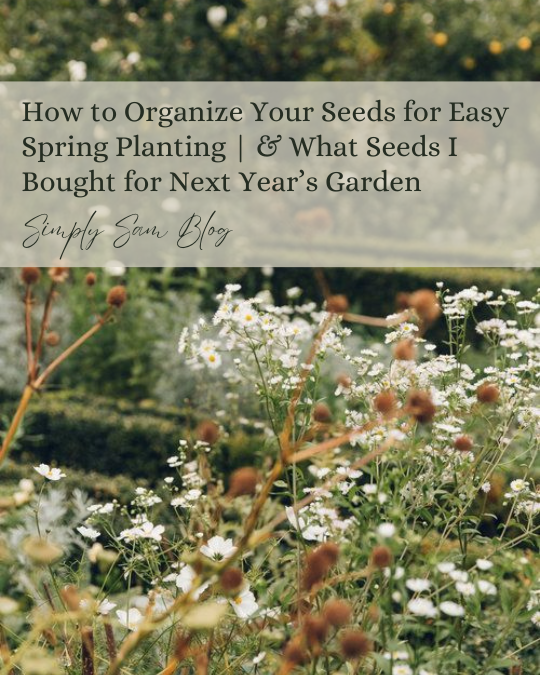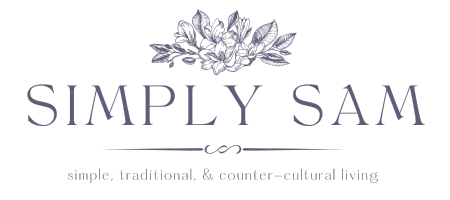I can’t believe it’s already time to start thinking about planning out next year’s garden. Here are my tips for how to organize your seeds for easy spring planting. I started doing these things last year and loved how easy they made the planting process.

I feel like I just planned out last summer’s garden. Yet here I am starting to plan out my garden for 2024. I live in north east Ohio, so I’m in Zone 6a. That means that my last frost is usually sometime in May. Sadly, there’s not much I can grow in the spring. But I start a lot of my seeds indoors while it’s still cold out so I can get a head start on the growing season. I can start some of the seeds in late February or early March, so I definitely need to get started on organizing.
I’m very excited for my garden this year. Last summer’s garden was a bit of a fail. I blame that on the fact that we got married right in the middle of when I should’ve been transplanting outside. The majority of my time was spent on the wedding and my garden sort of got neglected. Plus, the soil on our new land wasn’t the greatest. But yet again, I didn’t have time to amend it before I planted everything.
So, all in all, our garden was kind of rushed this year. And because of that, it didn’t do too well. Our tomatoes weren’t bad, but we didn’t get much of anything else. So needless to say, I’m excited to redeem myself this year in the garden.
why i start my seeds indoors
But anyway, let’s get into organizing our seeds. Before I tell you how to organize your seeds for easy spring planting, I’m going to share why I try to start the majority of my plants indoors instead of direct sowing them in the garden. Like I said earlier, since I live in Ohio, my growing season is very short. With the last frost being in the middle of May and the first frost being in October, we only get about 3 solid months of warm weather. Plus September which is better for cool weather plants.
Because of that, I want to get a head start on planting whenever I can. Starting some of my seeds indoors helps me accomplish that. It gets the germination and sprouting processes done indoors while it’s still too cold to plant outside. In some cases, that process takes a month or more. So if I waited until after the last frost, a lot of the warm weather would be wasted with that long process.
Now, some plants don’t do well when you start them indoors. So in those cases, I just direct sow the seeds outside in the garden. I’ll do that either after the last frost or a couple weeks before depending on what the seed packet says.
how to organize your seeds for easy spring planting
Now that I got that out of the way, let’s really get into organizing our seeds. This is my fourth year growing a garden. The first year, I didn’t really plan ahead. I just went to the store and bought seeds sometime in the spring, and planted them in them red solo cups. The second year I planned it out a little more and ordered my seeds from an online seed shop. Once I got them in, I organized them in this craft organizer that I got from Michael’s. In each of the smaller cases, I organized the seeds by vegetable type.
But last year, I decided to change it up. Instead of organizing the seeds by type, I organized them by seed start date. Each seed packet should tell you when you should either start your seeds indoors or direct sew them outside in relation to the last frost. Usually it’ll be dates like 10 weeks before, 6 weeks before, and 4 weeks before. So, I made one case for each of the dates.
Organizing the seeds in this way helps a ton when it’s time to start planting. Instead of having to look at each individual packet and determine which ones you should be planting at that time, you can just go to your case, pull out the one for the corresponding date, and plant those seeds. It’s so easy and stress-free. Seed-starting is a lot of work, and so organizing your seeds in this way takes some of the unnecessary work out of the whole process.
what seeds i bought for next year’s garden
If that was all a little bit confusing for you, I figured I would share all of the seeds I bought for next years garden and organize them in lists similarly to how I have them organized in the cases.
I get all of my seeds from Baker Creek Heirloom Seeds. I’ve always had a ton of success with them, and I also love that they’re heirloom. That means that they aren’t a hybrid between two different species of that plant. I like that because I’m able to save the seeds from the vegetables I grow for the next year. I’ll talk more about that another time in case that’s something you’re also interested in doing!
But anyway, here are all the seeds I bought and how I organized them.
Eight to Twelve Weeks Before the Last Frost
- Thyme
- Basil
- Oregano
- Rosemary
- Yarrow
- Lavender
- Echinacea
- Asparagus
- Jalapeno Peppers
- Bell Peppers
- Banana Peppers
Six to Ten Weeks Before the Last Frost
- Roma Tomatoes
- Genovese Tomatoes
- Brandywine Tomatoes
- Watermelon
- Butternut Squash
Four Weeks Before the Last Frost
- Sunflowers
- Marigolds
- Saint John’s Wort
- Calendula
- Dill
- Summer Squash
- Zucchini
- Cucumbers
- Lettuce
Direct Sow Three to Four Weeks Before the Last Frost
- Sweet Peas
- Cilantro
Direct Sow One to Two Weeks Before the Last Frost
- Sweet Corn
Direct Sow After the Last Frost
- Green Beans
- Boer Squash
- Jarrahdale Squash
- Sugar Pumpkins
- Chives
Direct Sow Midsummer for Fall Harvest
- Brussels Sprouts
- Carrots
- Bok Choy
- Cabbage
- Broccoli
Let me know what you plan on planting in your garden next year! If you haven’t gotten any seeds yet, I highly recommend Baker Creek! If you’re interested in garden content, make sure to follow along as I’ll be sharing more about gardening and my gardening process throughout the year. Also, let me know if you end up organizing your seeds in this way as well. If you liked this post, make sure you share it with someone else who would enjoy it and learn from it as well!
